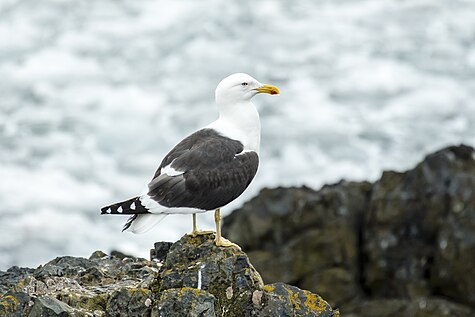Kelp gull
| Kelp gull | |
|---|---|
|
|
|
| Adult in Livingston Island, South Shetland Islands | |
| Scientific classification | |
| Kingdom: | Animalia |
| Phylum: | Chordata |
| Class: | Aves |
| Order: | Charadriiformes |
| Family: | Laridae |
| Genus: | Larus |
| Species: | L. dominicanus |
| Binomial name | |
|
Larus dominicanus Lichtenstein, 1823 |
|
The kelp gull (Larus dominicanus), also known as the Dominican gull, is a gull which breeds on coasts and islands through much of the southern hemisphere. The nominate L. d. dominicanus is the subspecies found around South America, parts of Australia (where it overlaps with the Pacific gull), and New Zealand (where it is known as the southern black-backed gull or by its Māori name karoro). L. d. vetula (known as the Cape gull) is a subspecies occurring around southern Africa.
The specific name comes from the Dominican Order of friars, who wear black and white habits.
The kelp gull superficially resembles two gulls from further north in the Atlantic Ocean, the lesser black-backed gull and the great black-backed gull and is intermediate in size between these two species. This species ranges from 54 to 65 cm (21 to 26 in) in total length, from 128 to 142 cm (50 to 56 in) in wingspan and from 540 to 1,390 g (1.19 to 3.06 lb) in weight. Adult males and females weigh on average 1,000 g (2.2 lb) and 900 g (2.0 lb) respectively. Among standard measurements, the wing chord is 37.3 to 44.8 cm (14.7 to 17.6 in), the bill is 4.4 to 5.9 cm (1.7 to 2.3 in) and the tarsus is 5.3 to 7.5 cm (2.1 to 3.0 in). The adult kelp gull has black upperparts and wings. The head, underparts, tail, and the small "mirrors" at the wing tips are white. The bill is yellow with a red spot, and the legs are greenish-yellow (brighter and yellower when breeding, duller and greener when not breeding). The call is a strident ki-och. Juveniles have dull legs, a black bill, a dark band in the tail, and an overall grey-brown plumage densely edged whitish, but they rapidly get a pale base to the bill and largely white head and underparts. They take three or four years to reach maturity.
...
Wikipedia


